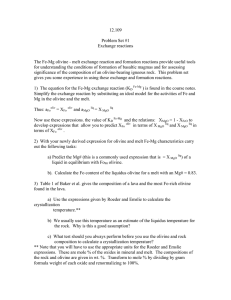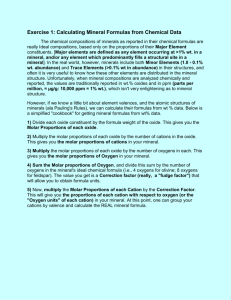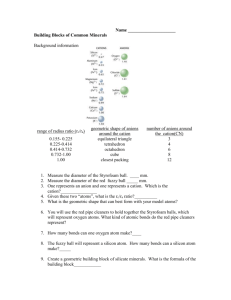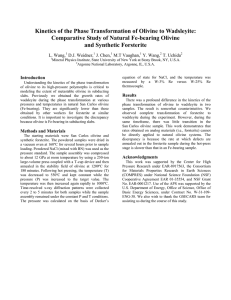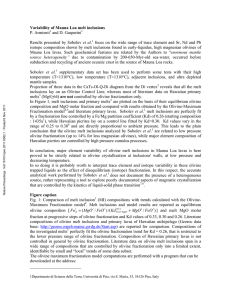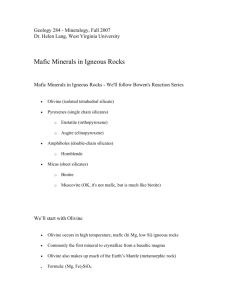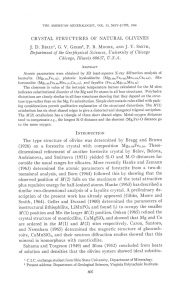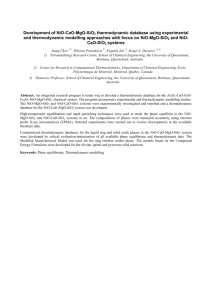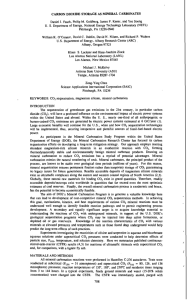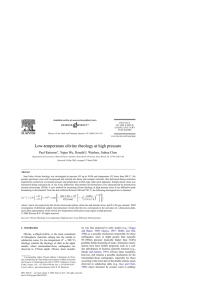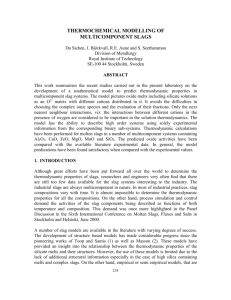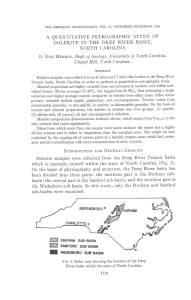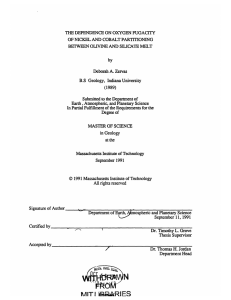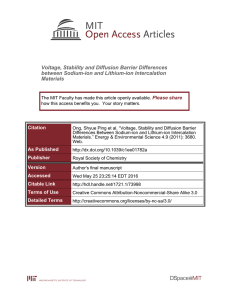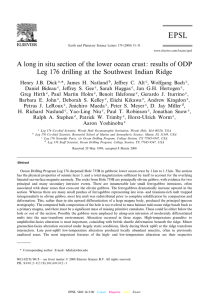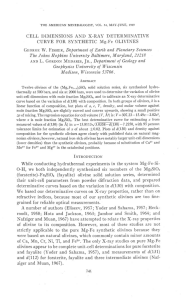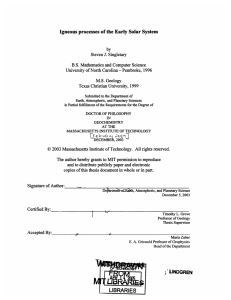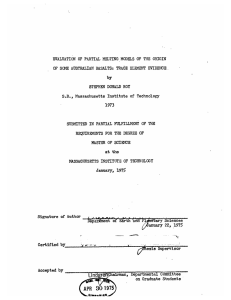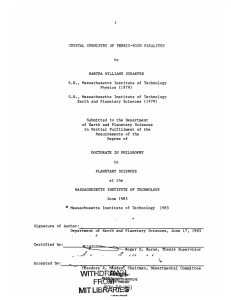Constructing mineral formulas: g chemical analyses to balanced ti
advertisement
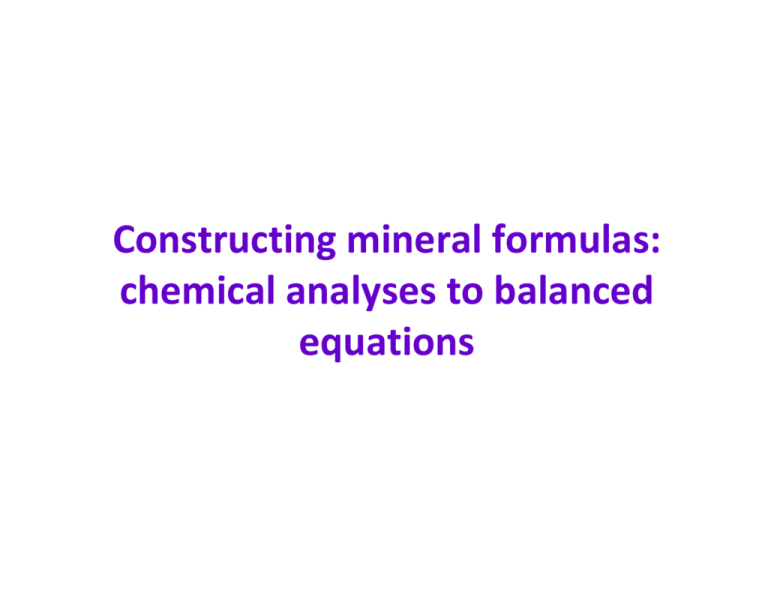
Constructing mineral formulas: g chemical analyses to balanced equations ti Basic terminology Atomic weight: tabulated in the periodic table of the elements (as well as table 10.1 in your text) average mass of an atom relative to 1/12 the mass of f 12C in its neutral & electronic ground state Ci i l& l i d Molecular weight: weight of all the atoms in a given molecule. H2O = 2H + 1O = (2*1.00794) + (1*15.9994) = 18.01528 Mole: the amount of an element that has an equal weight to its atomic weight or Avogadro’s Number (6.022 * 1023 atoms) of entities Atoms per formula units (apfu): numbers of atoms in a chemical formula O‐Factor: the apfu’ value scaled to a standard chosen number of oxygens based on the simplified mineral formula for a given mineral species 3 ways of expressing mineral composition Talc (sheet silicate usually formed from metamorphosed ultramafics) In terms of weight percent oxides (wt%) Chemical formula MgO SiO2 H2O MgO SiO2 H2O Mg3[Si4O10](OH)2 31.88 63.37 4.75 3 4 1 In terms of wt% elements and apfu’ Mg Si O H Mg Si O H Mg Si O H Mg Si O H 19.23 29.62 50.62 0.53 3 4 12 2 l1 An example from the Olivines Olivine is a solid solution series between an Mg and Fe rich set of end‐ members: Forsterite and Fayalite The general formula for Olivine is: (Mg, Fe) g ( g, )2[[SiO]]4 Chemical analysis (from Floran & Papike, 1973) SiO2 SiO2 TiO2 Al2O3 Fe2O3 FeO MnO MgO CaO TiO2 Al2O3 Fe2O3 FeO MnO MgO CaO 30.09 0 0 0 69.42 0.28 0.91 0.08 Which Olivine is this an analysis of? Which Olivine is this an analysis of? How can we calculate the formula in apfu’? How many oxygen atoms will we need to base the calculation on? An example from the Olivines Olivine is a solid solution series between an Mg and Fe rich set of end‐ members: Forsterite and Fayalite y The general formula for Olivine is: (Mg, Fe)2[SiO]4 Based on the general formula, we can now assign a new formula to this specific species of Olivine: (Mg0.0453Fe1.937Mn0.008Ca0.003)[Si1.004O1]4 Sum of M1 and M2 cations: 0.0453+1.937+0.008+0.003 = 1.9933 (~2) Octahedral coordination polyhedra of the mineral fayalite p y y The basic steps: 1) Convert from wt% oxide to wt% element using tabulated conversion factors and the appropriate atomic weight pp p g 2) Calculate the apfu’ values by dividing the wt% element by the atomic weight 3) Determine the total positive charge by multiplying the stated charge Determine the total positive charge by multiplying the stated charge and the apfu value for each element 4) Calculate how much oxygen is needed to balance the charge by taking the sum of the apfu charges and dividing by ‐2 taking the sum of the apfu charges and dividing by 2 5) Calculate the O‐factor based on the idealized chemical formula 6) Multiply the O‐factor by the apfu values Once these steps are complete, an analysis based on the oxides can be converted to a balanced formula The valance state problem The valance state of some species can vary from specimen to specimen and sometimes within single minerals While Cr (2+,3+), Ti (3+,4+), and V (2+ to 5+) are not very common others are, most notably Fe and Mn bl d Fe2+ (FeO) & Fe3+ (Fe2O3) as well as Mn2+ (MnO) & Mn3+ (Mn2O3) In order to develop an accurate mineral formula, the percentages of each valance state must be determined; however, EPMA and SEM are not accurate enough to do this. Therefore, Mössbauer spectroscopy or wet chemistry must be used to be precise. Mineral formulas based on oxides 1) Divide each oxide value by its molecular weight to obtain a molecular proportion p p 2) Multiply the molecular proportion of each oxide by the number of oxygens in the oxide formula oxygens in the oxide formula 3) Multiply the oxygen number of each oxide by some normalization constant (clear fractions) constant (clear fractions) 4) Multiply the normalized oxygen number by the number of cations per oxygen per oxygen. This is the atoms per formula unit value Muscovite: K2Al4[Si6Al2O20](OH,F) Muscovite: K ](OH F)4 Muscovite example Idealized formula: K2Al4[[Si6Al2O20]( ](OH,F) , )4 O + OH + F = ~24 oxygen/ anion units Final formula: K1.521Na0.193Mg0.999Fe2+0.082Fe3+0.039Ti0.037Al5.901[Si6.034O20](OH)3.823 Because of the structure of muscovite (the micas in general), it is very g y common to have isomorphous replacements for: K: Na, Rb, Cs, Ca, Ba , , , , Octahedral Al: Mg Fe, Mn, Li, Cr, Ti, V
